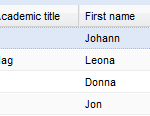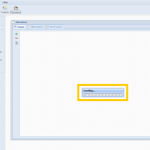It took some time, but now our application is available.
We did not change the original source code, so the installation contains our result after ~ 25 hours of work. The application is available as WebUI (html/ajax) application and as RIA (Applet). I think we were the only team with "two" frontends.
But after some good news we have a package with bad news: Most of our REST services do not work because we damaged the whole interface during our last deployment, so we are not happy with that. And last but not least, our start html for the RIA stuff is not correct. Time pressure is a killer 
Where were the problems?
It was not an enormous amount of time available, but it was absolutely possible to implement all MUSTs and most SHOULDs of the specification. For the MAYs it was not enough time.
Our biggest problem was the REST integration, because we did not have any support in JVx. We decided to implement a generic REST interface based on RESTlet. We knew that the decision is a high risk because it is easier to implement the REST service without regard to JVx. But we wanted to use the result as part of the framework. We were doing well but some problems with the authentication took more time as calculated and so we had big problems towards the end. We knew that the REST services are very important for the analysis phase by the jury, but it was not possible to fix all problems before the packaging phase. And it was better to deliver our work instead of fixing and not to deliver.
In summary: missing framework support and not enough experience with REST.
The frontend/database parts were straight forward, because JVx has powerful features. We developed with our Swing UI implementation and after we finished a task, we have tested with our Web UI implementation. Of course the Web UI had some limits and smaller problems, but we changed some smaller parts to meet the requirements.
In summary: worked great.
The look and feel of the result was not important, either for us nor for the specification, and we did not check the usability. It was important for us that we have a quick access to all controls. And of course, we normally don't create web portals with JVx. It was designed to develop business (database) applications, but we had surprisingly few problems.
What about unit tests and code quality?
Most tests were manual tests because we did not have a lot of complex workflows and we had not enough time for TDD. Of course, we used JUnit for the REST services and for iCalendar creation, but thats all (best not to start EMMA because our test coverage is holey). On the other side, we produced a perfect source code documentation because our checkstyle config did not tolerate any mistakes.
In summary: With the quality we are satisfied.
Team organization?
Martin handled the whole database stuff, most of the User Interface and all workflows
Roland was in a REST "loop"
René took the rest of the User Interface, Business logic, managed the Team, Deployment, Testing and WebUI fixes
We had no problems to work together, it is always easy if you know each other.
Resume
The result could have been better, but even worse - we have our lessons learned.
We had a lot of fun, a perfect organization team and two days of pure adrenalin paired with motivation.









 RSS-Feed
RSS-Feed